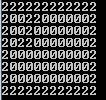Perl深度优先迷宫算法
迷宫求解,可以用穷举法,将每个点的方向都穷举完;由于在求解过程中会遇到某一方向不可通过,此时就必须按原路返回。
想到用Perl数组来保存路径,记录每次所探索的方向,方便原路返回时得到上一步的方向,再退回到可以通过的方向,继续探索,直到终点或者最终无法到达,正常退出程序为止。
求解过程的关键思想:
1、由于需要标记下一位置是否已探索,需要一个数组用来记录每个点是否可通过;
定义如:0--未经过 1--已走 2--不可通过
2、原路返回需要知道回退到哪个点,那么每一步要记录当前坐标;
3、采用深度优先搜索路径,每一步需记录搜索方向;
采用HASH表:{ coordinate=>[y,x] , direct=>'UP' }
4、用数组保存每一步,数组下标即代表当前步
关键算法:
北上,撞墙后原路返回,取出数组末元素,判断方向是否已搜索;已搜索完毕,继续原路返回;未搜索完,进行下个方向搜索,当前点放到数组尾。
循环。
5、算法伪码:
do{ if(当前点未经过){ 设置已走 将当前位置的坐标、方向保存 if(当前点为终点){ 修改迷宫的数据,记录所走的路线 return 1 } 当前步增一 新的坐标点=当前坐标+移动方向 } else{ # 当前位置走不通 if(数组非空){ 取出当前步 while(当前位置所走方向已搜索 && 数组非空){ 记录当前位置不可通过 取出上一步状态 原路返回 } if(当前的位置搜索方向小于4){ 当前位置的方向增一 数组重新记录当前步数 新的坐标点=当前坐标+移动方向 } } } }while(数组非空)
初始化迷宫:

初始化标记数组: 2、不可通过 0、未经过

路径:从蛇头到蛇尾

代码如下:
use strict; use constant {WIDTH=>12,HEIGHT=>8,DEBUG=>1,}; my %uldr=(1=>[-1,0], 2=>[0,-1], 3=>[1,0], 4=>[0,1],); # 上、左、下、右 my @bg=(); for(my $y=0;$y<HEIGHT;$y++){ for( my $x=0 ; $x<WIDTH ; $x++ ){ if( $y == 0 || $y == HEIGHT-1 || $x == 0 || $x == WIDTH-1 ){ $bg[$y][$x] = '*'; } else{ $bg[$y][$x] = ' '; } } } # 初始化迷宫 my @tmp=( [1,5],[1,4],[1,3],[2,3],[3,3],[3,2],[3,1], ); # 障碍物坐标 map{ $bg[ $tmp[$_][0] ][ $tmp[$_][1] ] = '#' } 1..$#tmp-1; $bg[ $tmp[0][0] ][ $tmp[0][1] ] = '@'; print @$_,"\n" foreach(@bg); my @bg_ghost=map{ [ split('','0'x (WIDTH)) ] }0..(HEIGHT-1); # 0--未经过 1--已走 2--不可通过 map{ my $y=$_;map { $bg_ghost[$y][$_] = ( $bg[$y][$_] eq '#' || $bg[$y][$_] eq '*')?2:0 }0..$#{$bg[0]} }0..$#bg; # 障碍物设置不可通过 print @$_,"\n" foreach(@bg_ghost); print "-"x15,"\n"; sub handle{ my @path=(); # 存放步数的数组 my $cur_position=[ $tmp[0][0] , $tmp[0][1] ]; # 起点 my $end=[ $tmp[-1][0] , $tmp[-1][1] ]; # 终点 my ($step,$p_step)=(0,''); # 步数、指向数组元素的指针 do{ if($bg_ghost[ $cur_position->[0] ][ $cur_position->[1] ] == 0 ){ # 当前位置未经过 $bg_ghost[ $cur_position->[0] ][ $cur_position->[1] ]=1; # 设置当前位置已走 $path[$step]={step=>$step, coordinate=>[$cur_position->[0],$cur_position->[1]], direct=>1, }; # 保存当前位置信息:坐标、方向 print "path[$step]:$path[$step]:",$path[$step]->{step},"\n" if DEBUG; print " (y,x):(",$cur_position->[0],",",$cur_position->[1],")\n" if DEBUG; if( $cur_position->[0]==$end->[0] && $cur_position->[1]==$end->[1]){ my @arr=('A'..'Z','a'..'z'); foreach(0..$#path){ $bg[ $path[$_]->{coordinate}->[0] ][ $path[$_]->{coordinate}->[1] ] = $arr[$_]; } return 1; } $step++; $cur_position=[ $path[$step-1]->{coordinate}->[0]+$uldr{1}->[0], $path[$step-1]->{coordinate}->[1]+$uldr{1}->[1] ]; } else{ # 当前位置已走/不可通过 if(@path){ $p_step=pop(@path); # 取出当前步 while($p_step->{direct}==4 && (@path)){ # 4个方向已经搜索完 $bg_ghost[ $p_step->{coordinate}->[0] ][ $p_step->{coordinate}->[1] ] = 2; # 设置不可通过 $p_step=pop(@path); # 上一步状态 $step--; # 上一步编号 } if($p_step->{direct}<4){ $p_step->{direct}++; print " step:",scalar(@path)," p_step->{direct}:",$p_step->{direct},"\n" if DEBUG; push @path,$p_step; my @temp=@{$p_step->{coordinate}}[0,1]; $cur_position = [ $temp[0]+$uldr{$p_step->{direct}}->[0], $temp[1]+$uldr{$p_step->{direct}}->[1] ]; print " (y,x):(",$cur_position->[0],",",$cur_position->[1],")\n" if DEBUG; } } } }while(@path); return 0; } my $x=&handle; print @$_,"\n" foreach(@bg);
运行信息如下:

path[0]:HASH(0x1585174):0 (y,x):(1,5) step:0 p_step->{direct}:2 (y,x):(1,4) step:0 p_step->{direct}:3 (y,x):(2,5) path[1]:HASH(0x15849f4):1 (y,x):(2,5) step:1 p_step->{direct}:2 (y,x):(2,4) path[2]:HASH(0x1584a14):2 (y,x):(2,4) step:2 p_step->{direct}:2 (y,x):(2,3) step:2 p_step->{direct}:3 (y,x):(3,4) path[3]:HASH(0x1584954):3 (y,x):(3,4) step:3 p_step->{direct}:2 (y,x):(3,3) step:3 p_step->{direct}:3 (y,x):(4,4) path[4]:HASH(0x1584924):4 (y,x):(4,4) step:4 p_step->{direct}:2 (y,x):(4,3) path[5]:HASH(0x1584884):5 (y,x):(4,3) step:5 p_step->{direct}:2 (y,x):(4,2) path[6]:HASH(0x158479c):6 (y,x):(4,2) step:6 p_step->{direct}:2 (y,x):(4,1) path[7]:HASH(0x158471c):7 (y,x):(4,1) path[8]:HASH(0x158463c):8 (y,x):(3,1)




